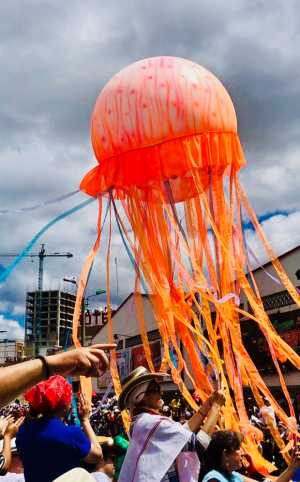The Carnaval de Negros y Blancos is the largest and most important festival in southern Colombia. It is celebrated from January 2 to January 7 each year. Every year, tourists from all over the country and abroad visit the city of Pasto to immerse themselves in this magical celebration.

About the Carnival
Every year, those who experience the Carnaval de Negros y Blancos in Pasto witness a collective and generous festivity that celebrates aesthetics and playfulness in a centuries-old city.

The carnival attracts those who enjoy colors, cosmetics, and talcum powder, the aesthetics of surreal floats, playful dance troupes, vernacular costumes, and fantastic choreographed groups whose rhythms accompany every moment of the festivities.
Pasto, the capital of the Nariño department, is usually seen as a quiet city in the Andean region.
However, at the beginning of each year, thousands of tourists arrive and are surprised to see a city transformed—one that shifts from its usual calm to a place that embraces creativity.
Just as the city of Pasto is centuries old, its carnival also dates back to the Colonial era. These celebrations, influenced by Spanish culture, shaped what would later become the Carnaval de Pasto.
The History of the Carnival
In the early 19th century, colonial authorities banned these festivities to prevent Indigenous uprisings. However, in 1834, celebrations reappeared with Indigenous people dancing with their children, mestizos wearing masks, and a general atmosphere of joy among neighbors.
At that time, these celebrations were linked to the religious calendar, mainly with the feasts of the Virgin of Mercy (September 24) and the Immaculate Conception of Mary (December 8).
Something Different Every Day
When it first began, the carnival lasted only two days, but by the 1920s, it had expanded to three days. Today, the celebration lasts five days.
Each day has a protagonist:
January 2: The stars of the day are children, who learn the traditions of the carnival and showcase their creativity in the “Carnavalito” parade.
January 3: The “Canto a la Tierra” (Song to the Earth) takes place. Eleven choreographic groups, each with around 250 participants, share the strength of the Andean culture through colorful costumes, dance, and music.

January 4: The “Familia Castañeda” and the carnival’s symbolic figure, Pericles Carnaval, officially welcome locals and visitors.
January 5: The “Day of the Black” takes place, where people celebrate Afro-Colombian heritage by painting their faces black.

January 6: The grand parade of floats and colors marks the end of the carnival.
During the Colonial period, on January 5, the sound of drums echoed through the streets of San Juan de Pasto. It was the one day of the year when enslaved Black people were granted freedom to celebrate.
They took to the streets, honoring their ancestors through music, dance, and food, and as a symbol of equality, they smeared white people with charcoal.
This event, which awakened the entire city, became known as the “fiesta de los negritos” (Little Black Festival). The enthusiasm was so contagious that white people joined in, putting aside their social status.
In September 2009, UNESCO officially recognized the Carnaval de Negros y Blancos as part of the Intangible Cultural Heritage of Humanity.

Starting the year with a new skin is the symbolic meaning that the people of Pasto have given to these five days of celebration. The carnival invites everyone to begin the year with a renewed and purified spirit, following a true collective catharsis.
A Fusion of Cultures
The Carnaval de Negros y Blancos originated from a fusion of multiple cultures and traditions from the Andes, Amazon, and Pacific regions.
This unique blend makes it stand out among other similar festivals—not just because of its timing but also due to its Indigenous origins, as it coincides with the celebration of the Moon (Quilla).

The carnival retains traces of the rituals once performed by the Pasto and Quillasinga peoples, agrarian cultures that, during harvest season, honored the moon through dance and prayed to the sun for protection over their crops.

The fantasy of its majestic floats, the lively music of traditional bands, the colorful dance troupes, and the captivating choreography all contribute to its unique charm.
The festival has increasingly become a perfect fusion of art, folklore, and play, bringing together different races, towns, and customs.
For four days, the city of Pasto, which usually has 500,000 inhabitants, doubles in population as tourists arrive from Cali, Bogotá, Medellín, and even from the neighboring country of Ecuador.
The foothills of the Galeras volcano have been the birthplace of great artists and artisans, who bring their inspiration, creativity, and ingenuity to the carnival, making it one of the best festivals in Colombia—and perhaps in all of South America.
What It Means
This is one of the most beloved celebrations in Colombia.
It is a magical event that brings together people of all ages and social backgrounds. Participants paint their faces with tiny figures, wear multicolored costumes, and dance through the streets, reviving the Indigenous spirit with traditional music and Andean folklore.
The passion, love, and sacrifice for the Carnaval de Negros y Blancos are evident in every aspect of the grand farewell on January 6. The celebration reaches its peak with music, talcum powder, streamers, and joyful shouts, all accompanied by the spontaneous cry:

¡Que viva Pasto, carajooooooo! (Long live Pasto, damn it!)
From that moment on, the Carnaval de Negros y Blancos in Pasto became a festival of unity and expression, where freedom, play, art, creativity, joy, and brotherhood are celebrated.
It is the perfect example of how people recreate the historic ritual of resisting monotony, elevating artistic expression, and dreaming of a different time and space.
The carnival is inclusive—it welcomes everyone. It does not need to imitate or compete but rather complements and contributes through affection and shared experiences. The music, colors, and imagination displayed in the festival’s various forms and characters are truly tangible. It encourages connection with others, and in this carnival, the streets become the ultimate stage. During these carnival days, the city transforms, and mythical beings emerge, embodying a ritual that renews the meaning of existence.


